Jiayi Zhang
Sherman
Decoding Human and AI Persuasion in National College Debate: Analyzing Prepared Arguments Through Aristotle's Rhetorical Principles
Dec 14, 2025Abstract:Debate has been widely adopted as a strategy to enhance critical thinking skills in English Language Arts (ELA). One important skill in debate is forming effective argumentation, which requires debaters to select supportive evidence from literature and construct compelling claims. However, the training of this skill largely depends on human coaching, which is labor-intensive and difficult to scale. To better support students in preparing for debates, this study explores the potential of leveraging artificial intelligence to generate effective arguments. Specifically, we prompted GPT-4 to create an evidence card and compared it to those produced by human debaters. The evidence cards outline the arguments students will present and how those arguments will be delivered, including components such as literature-based evidence quotations, summaries of core ideas, verbatim reading scripts, and tags (i.e., titles of the arguments). We compared the quality of the arguments in the evidence cards created by GPT and student debaters using Aristotle's rhetorical principles: ethos (credibility), pathos (emotional appeal), and logos (logical reasoning). Through a systematic qualitative and quantitative analysis, grounded in the rhetorical principles, we identify the strengths and limitations of human and GPT in debate reasoning, outlining areas where AI's focus and justifications align with or diverge from human reasoning. Our findings contribute to the evolving role of AI-assisted learning interventions, offering insights into how student debaters can develop strategies that enhance their argumentation and reasoning skills.
Reasoning via Video: The First Evaluation of Video Models' Reasoning Abilities through Maze-Solving Tasks
Nov 19, 2025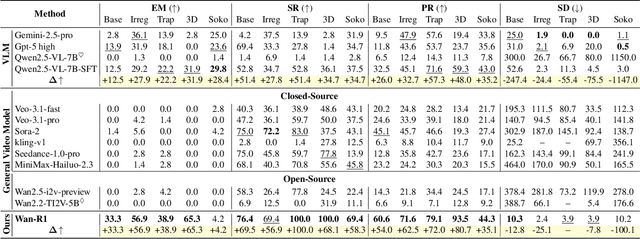
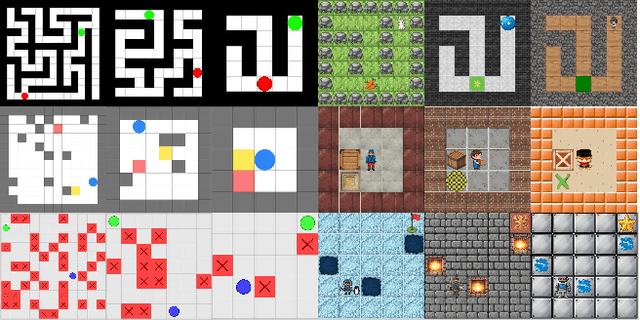
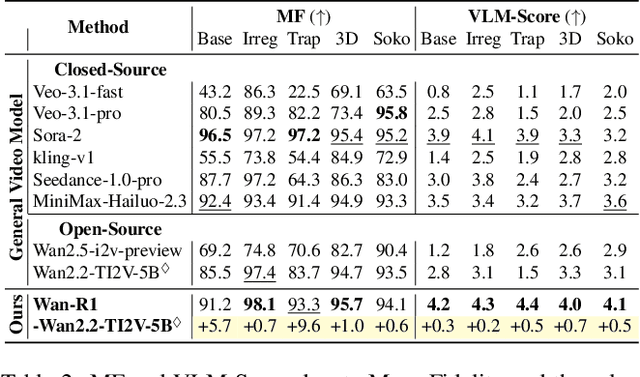
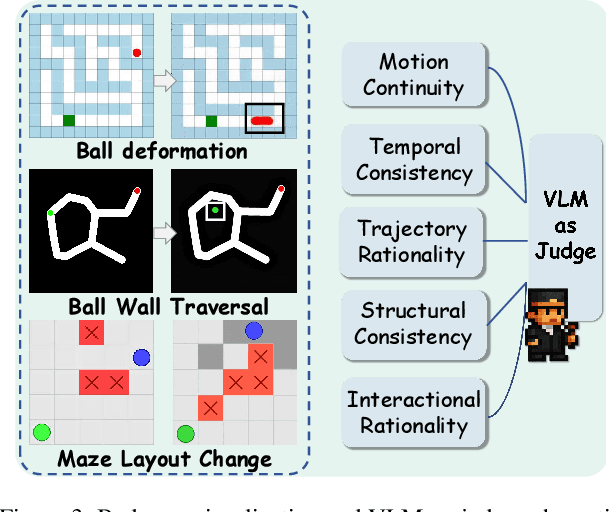
Abstract:Video Models have achieved remarkable success in high-fidelity video generation with coherent motion dynamics. Analogous to the development from text generation to text-based reasoning in language modeling, the development of video models motivates us to ask: Can video models reason via video generation? Compared with the discrete text corpus, video grounds reasoning in explicit spatial layouts and temporal continuity, which serves as an ideal substrate for spatial reasoning. In this work, we explore the reasoning via video paradigm and introduce VR-Bench -- a comprehensive benchmark designed to systematically evaluate video models' reasoning capabilities. Grounded in maze-solving tasks that inherently require spatial planning and multi-step reasoning, VR-Bench contains 7,920 procedurally generated videos across five maze types and diverse visual styles. Our empirical analysis demonstrates that SFT can efficiently elicit the reasoning ability of video model. Video models exhibit stronger spatial perception during reasoning, outperforming leading VLMs and generalizing well across diverse scenarios, tasks, and levels of complexity. We further discover a test-time scaling effect, where diverse sampling during inference improves reasoning reliability by 10--20%. These findings highlight the unique potential and scalability of reasoning via video for spatial reasoning tasks.
Opinion: Towards Unified Expressive Policy Optimization for Robust Robot Learning
Nov 13, 2025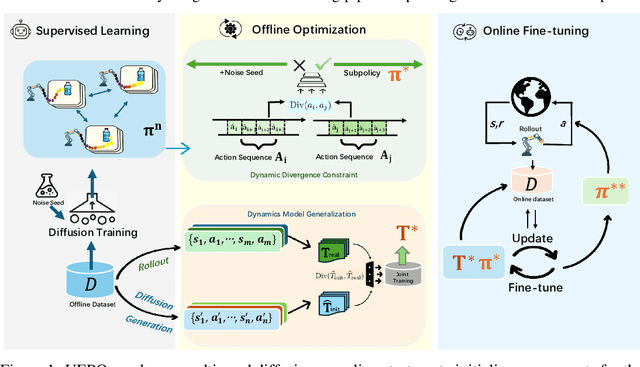
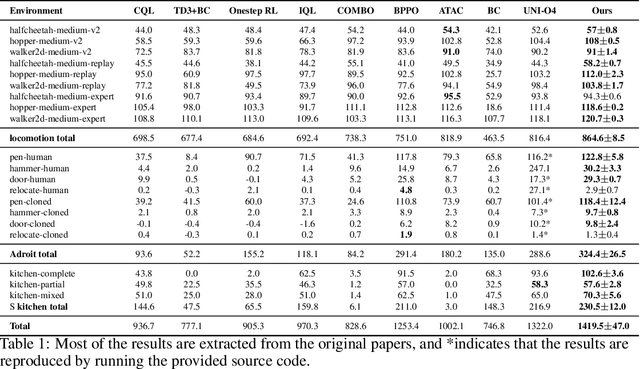
Abstract:Offline-to-online reinforcement learning (O2O-RL) has emerged as a promising paradigm for safe and efficient robotic policy deployment but suffers from two fundamental challenges: limited coverage of multimodal behaviors and distributional shifts during online adaptation. We propose UEPO, a unified generative framework inspired by large language model pretraining and fine-tuning strategies. Our contributions are threefold: (1) a multi-seed dynamics-aware diffusion policy that efficiently captures diverse modalities without training multiple models; (2) a dynamic divergence regularization mechanism that enforces physically meaningful policy diversity; and (3) a diffusion-based data augmentation module that enhances dynamics model generalization. On the D4RL benchmark, UEPO achieves +5.9\% absolute improvement over Uni-O4 on locomotion tasks and +12.4\% on dexterous manipulation, demonstrating strong generalization and scalability.
Multi-modal Dynamic Proxy Learning for Personalized Multiple Clustering
Nov 10, 2025Abstract:Multiple clustering aims to discover diverse latent structures from different perspectives, yet existing methods generate exhaustive clusterings without discerning user interest, necessitating laborious manual screening. Current multi-modal solutions suffer from static semantic rigidity: predefined candidate words fail to adapt to dataset-specific concepts, and fixed fusion strategies ignore evolving feature interactions. To overcome these limitations, we propose Multi-DProxy, a novel multi-modal dynamic proxy learning framework that leverages cross-modal alignment through learnable textual proxies. Multi-DProxy introduces 1) gated cross-modal fusion that synthesizes discriminative joint representations by adaptively modeling feature interactions. 2) dual-constraint proxy optimization where user interest constraints enforce semantic consistency with domain concepts while concept constraints employ hard example mining to enhance cluster discrimination. 3) dynamic candidate management that refines textual proxies through iterative clustering feedback. Therefore, Multi-DProxy not only effectively captures a user's interest through proxies but also enables the identification of relevant clusterings with greater precision. Extensive experiments demonstrate state-of-the-art performance with significant improvements over existing methods across a broad set of multi-clustering benchmarks.
VisJudge-Bench: Aesthetics and Quality Assessment of Visualizations
Oct 25, 2025Abstract:Visualization, a domain-specific yet widely used form of imagery, is an effective way to turn complex datasets into intuitive insights, and its value depends on whether data are faithfully represented, clearly communicated, and aesthetically designed. However, evaluating visualization quality is challenging: unlike natural images, it requires simultaneous judgment across data encoding accuracy, information expressiveness, and visual aesthetics. Although multimodal large language models (MLLMs) have shown promising performance in aesthetic assessment of natural images, no systematic benchmark exists for measuring their capabilities in evaluating visualizations. To address this, we propose VisJudge-Bench, the first comprehensive benchmark for evaluating MLLMs' performance in assessing visualization aesthetics and quality. It contains 3,090 expert-annotated samples from real-world scenarios, covering single visualizations, multiple visualizations, and dashboards across 32 chart types. Systematic testing on this benchmark reveals that even the most advanced MLLMs (such as GPT-5) still exhibit significant gaps compared to human experts in judgment, with a Mean Absolute Error (MAE) of 0.551 and a correlation with human ratings of only 0.429. To address this issue, we propose VisJudge, a model specifically designed for visualization aesthetics and quality assessment. Experimental results demonstrate that VisJudge significantly narrows the gap with human judgment, reducing the MAE to 0.442 (a 19.8% reduction) and increasing the consistency with human experts to 0.681 (a 58.7% improvement) compared to GPT-5. The benchmark is available at https://github.com/HKUSTDial/VisJudgeBench.
A Survey of Self-Evolving Agents: On Path to Artificial Super Intelligence
Jul 28, 2025



Abstract:Large Language Models (LLMs) have demonstrated strong capabilities but remain fundamentally static, unable to adapt their internal parameters to novel tasks, evolving knowledge domains, or dynamic interaction contexts. As LLMs are increasingly deployed in open-ended, interactive environments, this static nature has become a critical bottleneck, necessitating agents that can adaptively reason, act, and evolve in real time. This paradigm shift -- from scaling static models to developing self-evolving agents -- has sparked growing interest in architectures and methods enabling continual learning and adaptation from data, interactions, and experiences. This survey provides the first systematic and comprehensive review of self-evolving agents, organized around three foundational dimensions -- what to evolve, when to evolve, and how to evolve. We examine evolutionary mechanisms across agent components (e.g., models, memory, tools, architecture), categorize adaptation methods by stages (e.g., intra-test-time, inter-test-time), and analyze the algorithmic and architectural designs that guide evolutionary adaptation (e.g., scalar rewards, textual feedback, single-agent and multi-agent systems). Additionally, we analyze evaluation metrics and benchmarks tailored for self-evolving agents, highlight applications in domains such as coding, education, and healthcare, and identify critical challenges and research directions in safety, scalability, and co-evolutionary dynamics. By providing a structured framework for understanding and designing self-evolving agents, this survey establishes a roadmap for advancing adaptive agentic systems in both research and real-world deployments, ultimately shedding lights to pave the way for the realization of Artificial Super Intelligence (ASI), where agents evolve autonomously, performing at or beyond human-level intelligence across a wide array of tasks.
Joint Power Control and Precoding for Cell-Free Massive MIMO Systems With Sparse Multi-Dimensional Graph Neural Networks
Jul 02, 2025Abstract:Cell-free massive multiple-input multiple-output (CF mMIMO) has emerged as a prominent candidate for future networks due to its ability to significantly enhance spectral efficiency by eliminating inter-cell interference. However, its practical deployment faces considerable challenges, such as high computational complexity and the optimization of its complex processing. To address these challenges, this correspondence proposes a framework based on a sparse multi-dimensional graph neural network (SP-MDGNN), which sparsifies the connections between access points (APs) and user equipments (UEs) to significantly reduce computational complexity while maintaining high performance. In addition, the weighted minimum mean square error (WMMSE) algorithm is introduced as a comparative method to further analyze the trade-off between performance and complexity. Simulation results demonstrate that the sparse method achieves an optimal balance between performance and complexity, significantly reducing the computational complexity of the original MDGNN method while incurring only a slight performance degradation, providing insights for the practical deployment of CF mMIMO systems in large-scale network.
FIMA-Q: Post-Training Quantization for Vision Transformers by Fisher Information Matrix Approximation
Jun 13, 2025Abstract:Post-training quantization (PTQ) has stood out as a cost-effective and promising model compression paradigm in recent years, as it avoids computationally intensive model retraining. Nevertheless, current PTQ methods for Vision Transformers (ViTs) still suffer from significant accuracy degradation, especially under low-bit quantization. To address these shortcomings, we analyze the prevailing Hessian-guided quantization loss, and uncover certain limitations of conventional Hessian approximations. By following the block-wise reconstruction framework, we propose a novel PTQ method for ViTs, dubbed FIMA-Q. Specifically, we firstly establish the connection between KL divergence and FIM, which enables fast computation of the quantization loss during reconstruction. We further propose an efficient FIM approximation method, namely DPLR-FIM, by employing the diagonal plus low-rank principle, and formulate the ultimate quantization loss. Our extensive experiments, conducted across various vision tasks with representative ViT-based architectures on public datasets, demonstrate that our method substantially promotes the accuracy compared to the state-of-the-art approaches, especially in the case of low-bit quantization. The source code is available at https://github.com/ShiheWang/FIMA-Q.
Flexible MIMO for Future Wireless Communications: Which Flexibilities are Possible?
Jun 09, 2025Abstract:To enable next-generation wireless communication networks with modest spectrum availability, multiple-input multiple-output (MIMO) technology needs to undergo further evolution. In this paper, we introduce a promising next-generation wireless communication concept: flexible MIMO technology. This technology represents a MIMO technology with flexible physical configurations and integrated applications. We categorize twelve representative flexible MIMO technologies into three major classifications: flexible deployment characteristics-based, flexible geometry characteristics-based, and flexible real-time modifications-based. Then, we provide a comprehensive overview of their fundamental characteristics, potential, and challenges. Furthermore, we demonstrate three vital enablers for the flexible MIMO technology, including efficient channel state information (CSI) acquisition schemes, low-complexity beamforming design, and explainable artificial intelligence (AI)-enabled optimization. Within these areas, eight critical sub-enabling technologies are discussed in detail. Finally, we present two case studies-pre-optimized irregular arrays and cell-free movable antennas-where significant potential for flexible MIMO technologies to enhance the system capacity is showcased.
FastCache: Fast Caching for Diffusion Transformer Through Learnable Linear Approximation
May 26, 2025Abstract:Diffusion Transformers (DiT) are powerful generative models but remain computationally intensive due to their iterative structure and deep transformer stacks. To alleviate this inefficiency, we propose FastCache, a hidden-state-level caching and compression framework that accelerates DiT inference by exploiting redundancy within the model's internal representations. FastCache introduces a dual strategy: (1) a spatial-aware token selection mechanism that adaptively filters redundant tokens based on hidden state saliency, and (2) a transformer-level cache that reuses latent activations across timesteps when changes are statistically insignificant. These modules work jointly to reduce unnecessary computation while preserving generation fidelity through learnable linear approximation. Theoretical analysis shows that FastCache maintains bounded approximation error under a hypothesis-testing-based decision rule. Empirical evaluations across multiple DiT variants demonstrate substantial reductions in latency and memory usage, with best generation output quality compared to other cache methods, as measured by FID and t-FID. Code implementation of FastCache is available on GitHub at https://github.com/NoakLiu/FastCache-xDiT.
 Add to Chrome
Add to Chrome Add to Firefox
Add to Firefox Add to Edge
Add to Edge